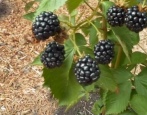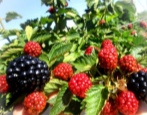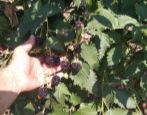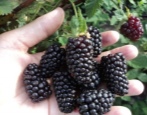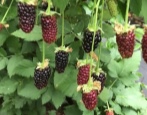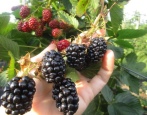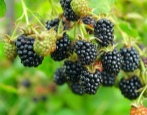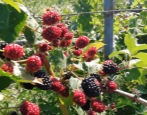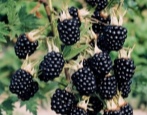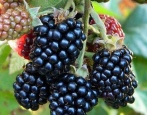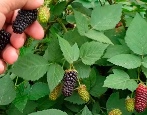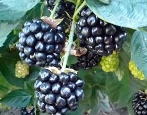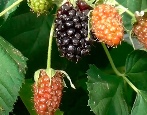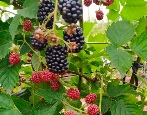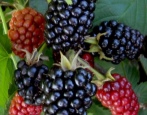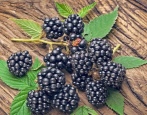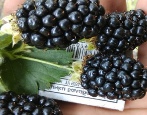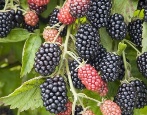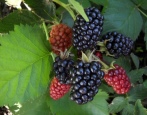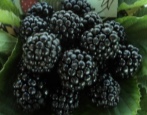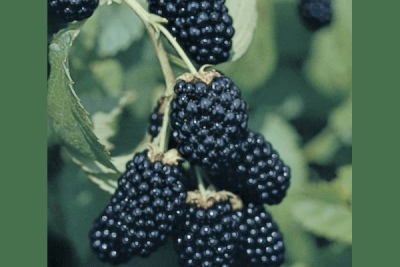
- Authors: American selection
- Taste: sweet and sour
- Scent : there is
- The presence of thorns: No
- Berry weight, g: 5-8
- Berry size: large
- Berry color: black
- Fruiting period: mid-July to mid-September
- Yield: 12-20 kg per bush
- Frost resistance, ° C / Winter hardiness: medium
Blackberry Doyle is a plant with a high keeping quality of fruits. Its other features are therefore clearly noteworthy. After reading the article, you can figure out the taste, frost resistance and other parameters.
Breeding history of the variety
Blackberry Doyle is a product of the selection of the USA. Most importantly, this is a completely new culture. All rights to this plant belong to the family after which it is named. There are no other official suppliers of seed. Its cost is very high, especially taking into account the transportation; synonym in foreign sources - Doyle's.
Description of the variety
Ripening terms
Doyle is a typical mid-season blackberry. Fruit picking begins in mid-July. With more or less stable weather, it can continue until the middle of the calendar autumn.
Yield
The official description of the variety indicates that it can bring more than 75 kg of berries from a bush. But this is most likely a marketing ploy or a description of some single unique examples. However, even more real 12-20 kg per plant are quite impressive. Rarely does a variety even come close to this indicator. Fertility is associated with a large number of sideways growing shoots.
Berries and their taste
Sweet and sour pulp is hidden under the black surface of the fruit. The fruits have a good aroma. The berries are round and slightly extended forward. Weight of 1 fruit varies from 5 to 8 g. There are no thorns.
Growing features
Site selection and soil preparation
Doyle can be cultivated even in relatively dry places. Loams are preferred. Good sunlight is very important. The optimum gap between blackberry bushes is 3 to 4 m. Since the plants are up to 4 m tall, it is not recommended to grow them under low wires and gutters.
It is also useful to protect the culture as much as possible from the piercing winds. Before starting work, the earth needs to be dug up. The wells are supposed to be saturated with drainage. It is advised to add compost to both clay and sandy soil; besides it, potassium sulfate and superphosphate are used. Rocky, sandy and waterlogged places are poor for Doyle.
Pruning
As soon as the blackberries are planted, they are immediately shortened by 0.2 m. Removing the tips of the branches activates the growth from the side. Dried branches are harvested in the spring. As soon as fruiting is completed, all recently active shoots are eliminated, which can draw off resources from the plant for laying shoots for the next year. If you did not succeed in doing this procedure in the fall, you need to do the same at least in the spring, although this is already less effective.
Watering and feeding
There are some nuances here:
at the beginning of the growing season, nitrogen fertilizers are applied;
in the formation of fruits, blackberries need phosphorus;
with the end of the growing season and the approach of winter, the need for potassium increases;
feeding with chicken droppings is promising;
for 1 bush, you need to use 15-20 liters of water every week.
Frost resistance and preparation for winter
Resistance to winter conditions - medium; but it is better to cover the bushes. Before the cold weather begins, you need:
collect shoots in bunches;
bend them to the ground;
fix with hooks or wire;
cover with sawdust, peat, agrofibre.
Diseases and pests
The danger is powdery mildew. When infected with it, all diseased parts of the plant must be completely removed. Landing rarefaction will also be a positive measure. Additionally, three times the fungicide treatment is required. The same preparations, sometimes in combination with Iprodion, effectively remove gray rot.
Infection with anthracnose and purple spot is also a threat. Of the harmful insects, it is worth mentioning raspberry and spider mites. Doyle's blackberry is also often affected by pests that have passed from:
pepper;
potatoes;
tomatoes and other members of the nightshade family.
Reproduction
To breed this blackberry, you can use cuttings, seeds and cuttings. However, the seed method, due to the difficulties with germination, is suitable mainly for breeding. Reproduction by offspring is impossible. Occasionally, air layers are used, covered with cellophane. When the shoots develop, they are separated and planted.


